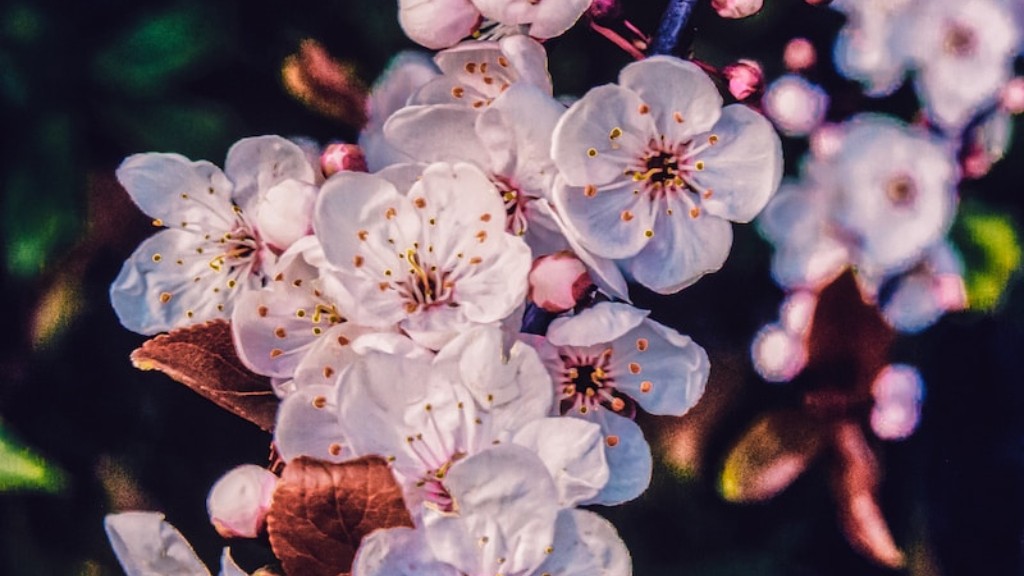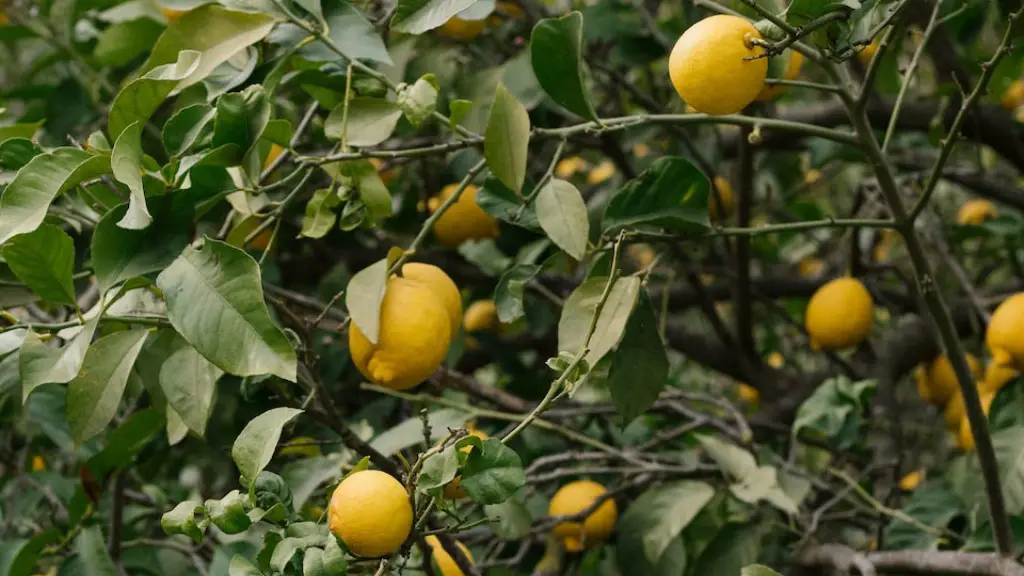Cherry trees are an iconic tree species that can be found in many countries around the world. For those in the United States, cherry trees may be more familiar in Pennsylvania, and some may even be found in California, but what about Florida? Is it even possible for a cherry tree to thrive and grow in the sweltering heat and humidity of the Sunshine State?
As with any tree species, the specific varieties of cherry trees available for planting in Florida are determined by the amount of heat and humidity the tree can tolerate during its life span. While there are many varieties of cherries that can survive in areas with more extreme conditions, some are not suitable for Florida, due to the temperatures and high humidity that occur there.
The University of Florida’s Institute of Food and Agricultural Sciences provides an excellent resource for selecting the right type of cherry tree for growing in the state. The institute recommends trees that can tolerate the climatic differences between North and South Florida, as well as other related issues such as flooding, drought and soil type. Trees should be selected with respect to the micro-environmental conditions that exist throughout the state.
When selecting a tree, it is important to choose one that is compatible with local environmental conditions, such as soil composition and temperatures. For instance, some varieties of cherry trees need full sun and well-draining soil, while others are more tolerant of shade and less tolerant of dry conditions. It is also important to consider the size that the tree will eventually reach, as some varieties can get too large for smaller gardens. Additionally, cherry trees need to be pruned annually to maintain their growth and health, and some varieties require more pruning than others.
It is also important to take into account future climate changes that could affect the tree’s ability to remain viable in Florida’s climate. According to the US Department of Agriculture’s Plant Hardiness Zone Map, Florida is projected to experience warmer temperatures over the next several decades. Therefore, it is important to choose a type of cherry tree that can tolerate these potential increases in temperature.
To ensure that a cherry tree grows successfully and produces the most delicious fruit possible, it is imperative to select the right type of tree for the environment. With the right combination of tree variety and good soil, as well as proper pruning, fertilizing and pest control, cherry trees can be a beautiful addition to any Florida landscape.
Choosing the Right Variety of Cherry Tree
Cherry trees are a diverse group of plants, with different varieties adapted to different climates, soil types and moisture levels. Some cherry trees require full sun, while others are more tolerant of shade. Some are hardy in cold climates while others are better suited to warmer climates. The UF/IFAS recommends choosing a variety such as Black Tartarian, Bing, or Bigarrera Rouge that are hardy throughout Florida.
To help narrow down the selection, it is important to consider the size of the tree and its growth rate. For example, a smaller tree may be better for those with limited outdoor space, while those with more room might consider a larger variety. Additionally, it is important to determine which types of cherries will be produced from the tree. The Black Tartarian is a popular variety that produces large, dark, flavorful cherries, while the Bing is known for its sweet, juicy fruit.
Tree care should also be taken into consideration before planting a cherry tree. It is important to ensure that the tree will receive proper sun and water depending upon the variety. In general, cherry trees require regular pruning to promote healthy growth and production of fruit, as well as mulching to prevent weed growth, and fertilizing according to the needs of the specific variety.
Where to Plant a Cherry Tree in Florida?
When selecting a location for planting, it is important to consider which of Florida’s micro-climates the tree will best adapt to. Northern Florida, for example, has higher temperatures but is also more prone to cold snaps and strong winds. On the other hand, Southern Florida is warmer but subject to flooding, higher humidity and salt-water intrusion.
Additionally, trees should be planted in an area that is well-drained to ensure that the roots do not rot and to keep the tree from accumulating too much water after a heavy rain. Furthermore, the area should receive adequate sun to promote fruit-setting and ripening in the spring and summer.
Pests, Diseases & Other Considerations
Once a cherry tree has been identified and planted, it is important to be aware of potential pests and diseases that may affect the health of the tree. For instance, the most common pest that affects cherry trees in Florida is the black cherry aphid, which can cause defoliation and can even kill the tree if not treated properly. Additionally, fungal diseases such as powdery mildew can cause distorted woody growth and discoloration of the leaves and fruits.
To protect the health of the tree, it is important to regularly inspect the tree for any signs of pest infestation or disease. If any are found, it is best to contact a local expert, such as a Certified Arborist, for assistance. Additionally, it is important to prune the tree properly and use mulch to promote healthy root and soil development. Additionally, watering should be done only when necessary, as too much water can lead to rot and other plant diseases.
Finally, it is important to remember that although cherry trees are generally considered an easy-to-care-for tree, they do require some maintenance to remain healthy and produce delicious fruit. Regular pruning, pest control and fertilizing are essential for the long-term health and success of a cherry tree in Florida.
Harvesting & Storing Cherries
Harvesting cherries is a straightforward process that involves determining when the cherries are ripe, as well as carefully removing the fruit from the tree without damaging the branches. It is important to note that not all cherries on a tree will ripen at the same time, so multiple harvests may be necessary. Additionally, it is important to ensure the fruit is harvested before birds find the cherries and begin eating them.
Once harvested, cherries should be transferred to a cool environment immediately. If cherries are left to sit in the heat, the flesh will become soft and quickly spoil. The best way to store cherries is to first wash them and then lay them out to dry. They can then be stored in a plastic bag in the refrigerator or in a cool, dry spot away from direct sunlight. Freshly picked cherries should be consumed within two weeks of harvesting.
Uses of Cherries in Florida
Cherries can be used in a variety of ways, from sweet treats like pies and cakes, to savory dishes. Cherries are known for their sweet-tart flavor, and their natural sugars make them ideal for jams and preserves. Furthermore, cherries can be dried and made into a delicious snack or used for baking. Additionally, cherries are a great addition to salads and can also be used for syrups and alcoholic drinks. The bright colors of the fruit also make them great decoration for cakes, cupcakes and other baked goods.
For those looking to take full advantage of the cherries produced from their cherry tree, it is important to know the exact ripening dates for the specific variety being grown. Knowing the correct ripening date for a particular variety can help one maximize the amount of cherries that can be harvested. Additionally, it is important to remember to pick cherries that are soft but not overripe, as overripe cherries will not last long.
Care When Growing a Cherry Tree in Florida
When a cherry tree is planted in Florida, it is important to remember to monitor the tree closely approximately one year after planting to ensure that it is healthy. Additionally, it is important to inspect the tree for signs of pests or disease throughout the year. To help prevent the spread of pests, it is important to only plant certified trees purchased from a reputable nursery. Additionally, it is important to regularly prune the tree and water only when necessary. Using mulch around the tree can also help keep weeds at bay and can also help keep the tree’s roots cool in the summer. Finally, it is important to fertilize the tree each year to ensure that it receives adequate nutrients for healthy growth and production of fruit.
Transporting & Selling Cherries
Once cherries are harvested, it is important to ensure they are properly packaged when transported and sold. Cherries should be carefully packed in insulated containers and gel packs and kept at temperatures below 50°F to prevent them from spoiling. Additionally, cherries should never be exposed to direct sunlight and should be kept away from other fruits and vegetables as certain fruits such as apples release ethylene gas that can accelerate the ripening process.
Cherries can be sold through a variety of sources, including markets, roadside stands and online retailers. It is important to research not just the local laws, but also any regulations that might be specific to a region before selling any type of fruit. Additionally, it is important to ensure that the cherries are of the highest quality, and that all safety guidelines are followed when packaging and transporting the fruit.
Conclusion
Cherry trees are one of the most beloved and iconic trees in the world, and they can be a beautiful addition to any Florida landscape. However, growing cherry trees in Florida requires careful consideration of the micro-environmental conditions, as well as the right variety of tree and proper maintenance. Once a cherry tree is planted and cared for properly, it can produce delicious and plentiful fruit that can be enjoyed for years to come.



